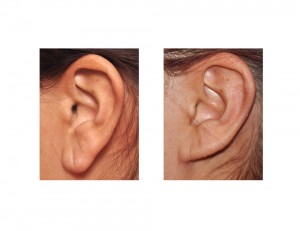Prominent ears are the most common reason for an aesthetic otoplasty correction. There are numerous reasons that one has ears that stick out too far from the absence of the antihelical fold, a large concha or combinations thereof. The surgical techniques used to treat prominent ears are based on creating a more defined antihelical fold, reducing the size of the concha and/or reducing the concha-scapha angle. Generally the size of the ear is usually not of significance as the vertical height of the ear is normal.
In the May 2015 issue of the journal Plastic and Reconstructive Surgery, an article as published entitled ‘Precision in Otoplasty: Combining Reduction Otoplasty with Traditional Otoplasty’. In this paper the authors looked at a series of otoplasty patients who also had some degree of macrotia (long ears in addition to protruding ears) Over a three year period the authors reviewed over 80 otoplasty patients of which 30 had some scaphal reduction at the same time. (36%) The scapha reduction was performed from a lateral incision inside the helical rim. The helical rim was reduced to accomodate the reduced scapha. Earlobe reduction was performed at the same time in five patients. (6%) Almost 25% of the treated patients were revisions of a prior otoplasty of which they were dissatisfied. The results from 6 to 12 months after surgery had a 100% high satisfaction rate with no significant complications. (tissue loss, infection or shape recurrence) The only visible scar was on the helical rim with some slight notching.

Protruding ears that are also enlarged are an underrecognized type of otoplasty patient. An enlarged scapha makes it difficult to set the protruding ear back properly and runs the risk of it being either under or over corrected. Scapha reduction offers a direct approach to the enlarged ear in either the primary or secondary otoplasty patient.
Dr. Barry Eppley
Indianapolis, Indiana


